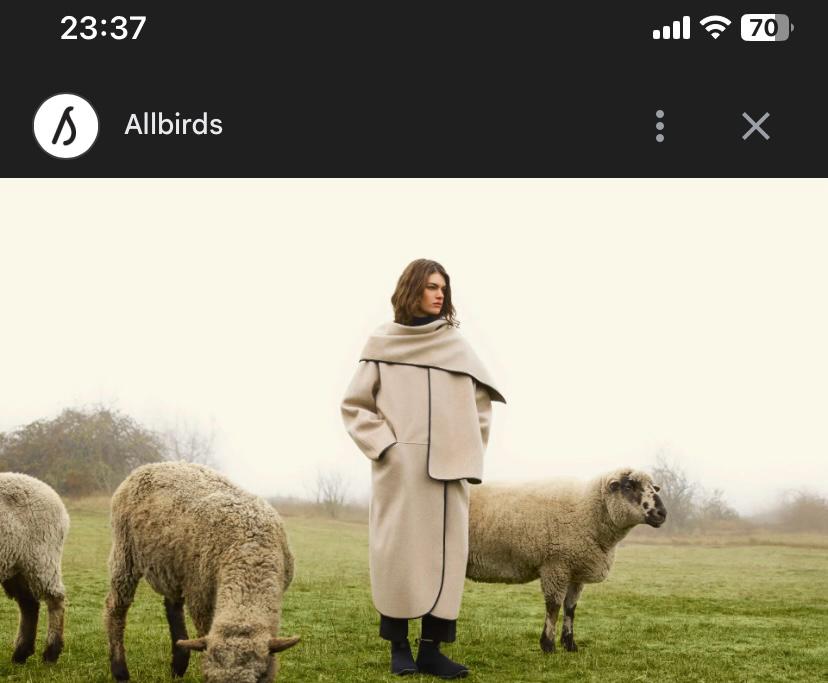The Allbirds Promise
Allbirds, a footwear company, frequently advertises on social media platforms, including my cellphone. One advertisement caught my attention whilst I was scrolling on Instagram. It caught my attention due to its emphasis on sustainability and ethical production. The advertisement features a serene image of sheep grazing in a lush, green field, subtly conveying a message of environmental responsibility. The advertisement ‘s power lay in its immediate evocation of tranquility. The visual of sheep grazing in a verdant landscape, so common on platforms like Instagram that are often filled with fast-paced content, acted as a visual pause. The company claims to use sustainable materials like merino wool and recycled plastic bottles to create their shoes, minimizing their environmental impact. These examples provide tangible proof points that ground the abstract concept of sustainability. Merino wool evokes natural fibers and animal welfare (if sourced ethically), while recycled plastics speak to circular economic principles, directly addressing concerns about waste and pollution.
The core message of the Allbirds advertisement is that consumers can enjoy comfortable, stylish footwear without compromising their environmental values. The advertisement aims to convince viewers to purchase Allbirds shoes, promoting the idea that buying their products is a step towards a more sustainable lifestyle. By associating their brand with eco-friendly practices, Allbirds seeks to cultivate a positive brand image and attract consumers who are increasingly conscious of their ecological footprint. Therefore, Allbirds positions itself not as a compromise, but as an enhancement, allowing individuals to express their style and enjoy comfort while simultaneously acting on their values.
I am part of the Allbirds’ target audience because l am a young adult who is environmentally conscious and active on social media. Allbirds typically targets millennials and generation Z, who are known for their environmental awareness and willingness to support brands that align with their values and also active on social media platforms. The advertisement appealed to me because it presents a simple solution to a complex problem: reducing environmental impact through everyday purchases. The visual imagery of nature and the promise of sustainable materials resonated with my personal values.
Theoretical Application and critical analysis
The Allbirds advertisement effectively employs the rhetorical device of ethos, establishing credibility by highlighting their commitment to sustainability. This aligns with the rhetorical concept of corporate social responsibility, where companies integrate social and environmental concerns into their business operations. A critical analysis, following advertising guidelines, reveals that the advertisement relies heavily on visual symbolism. The idyllic imagery of sheep in a pristine environment creates a sense of natural harmony, subtly suggesting that Allbirds products are inherently good for the planet. However, it is essential to critically evaluate the extent of their sustainability claims, as some critics argue that “greenwashing” is prevalent in the fashion industry (Banerjee, 2002). Furthermore, the advertisement uses framing to present Allbirds as a solution to environmental problems, potentially overlooking other factors contributing to ecological issues (Entman, 1993).
As the global quest for sustainability and environmental commitment becomes increasingly urgent, many consumers are now opting for products and brands aligned with their values (Mintel 2021). Indeed, according to a survey by the European Commission, 56% of average European consumers declared that “environmental concerns influenced their purchasing decisions” (EC 2021). Consequently, companies are now revising their marketing and advertising strategies in order to focus on eco-friendly claims, thus reversing the traditional image of passive consumers manipulated by advertisers (Wilke et al. 2021). In this context, the present paper investigates eco-friendly discourse and sustainability claims in a dataset of Italian food and drinks television commercials. The study considers 15 commercials recently aired in Italy for a qualitative manual analysis of textual and language features, in line with traditional CDA methods (Huckin 1997); a critical evaluation of environmental claims through a framework for greenwashing detection (Carlson et al. 1993) is also included. While attention is placed on critical aspects such as power relations between businesses and consumers, results suggest that environmental and sustainability topics are exploited in advertising to provide evidence of companies’ sustainability commitment, and to please conscious consumers asking for more responsible production.
In conclusion, the Allbirds advertisement is a compelling example of how companies leverage environmental consciousness to appeal to consumers. While the advertisement effectively communicates its message and resonates with its target audience, it is crucial to critically analyze the underlying claims and consider the broader context of sustainable consumption. As consumers, we must remain vigilant and demand transparency from companies that claim to be socially and ecologically responsible (Irvine, 2004).
Bibliography
Primary Sources
Banerjee, S. B . (2002). Corporate environmentalism: The construct and its measurement. Journal of Business Ethics, 37(2), 177-191.
Entman, R.M. (1993). Framing: toward clarification of a fractured paradigm. Journal of communication, 43(4), 51-58.
Irvine, A. (2004). Working at environmental justice: A reader. Journal of Political Ecology, 11(1), 87-90.


Isabelle Catenaccio
Throughout the analysis, Hazel identifies and breaks down one of the Seven Sins of Greenwashing, hidden trade-offs. The sources provided detail corporate environmentalism and the practices used to portray a company as eco-friendly. Hazel goes on to compare these tactics to the ones used by Allbirds shoe company. Hazel argues that through the use of idyllic scenery and the promotion of sustainable production, Allbirds is able to favor itself as an eco-friendly enhancement to one’s life. Through making these claims, consumers are able to align their values with fashion. She confirms this theory through citing a statistic claiming that environmental concerns impacted the purchasing decisions of 56% of European consumers. Ethos is mentioned as a tactic used by Allbirds to emphasize their commitment to sustainability. Through guiding the consumers under the guise of sustainability, companies are able to subtly integrate social and environmental concerns into their practices, therefore attracting customers who are looking to improve their ecological footprint. The use of Hazel’s 3 scholarly sources helped provide a framework for how companies are able to present themselves and their ‘values’ in order to achieve a certain demographic. Hazel does a great job at making a point, and then backing it up with data or information from her sources.